| This article's lead section may be too short to adequately summarize the key points. Please consider expanding the lead to provide an accessible overview of all important aspects of the article. (September 2021) |

First Period is an American architecture style originating between approximately 1626 and 1725, used primarily by British colonists during the settlement of the British colonies of North America, particularly in Massachusetts and Virginia. Among U.S. counties, Essex County, Massachusetts has the highest number of preserved First Period architecture buildings.
Typical features
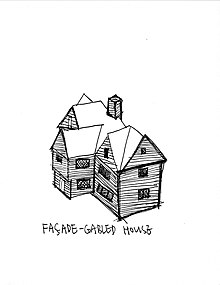
- South-facing
- Central chimney
- Asymmetrical rooftop
- Small diamond shaped casement windows
- Façade-gabled
The harsh winter weather in the colonies proved to be dangerous. To adapt to the conditions, First Period houses are built facing south to optimize sunlight and allow the house to be heated better. First Period houses are often constructed with a central chimney, to allow multiple rooms on multiple floors to have a fireplace and further maximize heat during the winter.
A gabled, asymmetrical rooftop helps prevent snow from accumulating on the roof during snowy winters. It also provides extra light for the attics through small casement windows. A still standing example of a First Period house in the British colonies is the Ross Tavern in Ipswich, Massachusetts, built in 1680.
Interior features
- Heavy oak frame
- Exposed chamfered summer beams (front room)
- L-shaped staircases
Inside, walls were furnished with clay and twigs to act as insulation. Staircases are often built in an L or U shape around the central chimney. A heavy oak frame and thick wooden beams are used to maintain the house structure.
Wooden frames of First Period houses were smoothed by planes, whereas timber frames of later colonial architecture styles were roughly adzed and incomplete. Due to the lack of an architect, the frame was often left exposed.
Floor plan
First Period houses were constructed with less variable floor plans. The most common plan is two-room central-chimney, found in Massachusetts Bay. Another variation of floor plan was a one-room-deep linear plan, which featured a small porch or hall immediately after the main entrance with large rooms on either side. The rooms would be separated by the central chimney and the staircase leading to the second floor. The second floor was usually a similar layout, but with the addition of sleeping quarters.
Transformation of styles
Houses built before c. 1660
First Period architecture could be divided into three periods of time, the earliest immigrants constitute this age category from settlement to the 1660s. Ten existing houses in Massachusetts have been proved that they were built before 1660 based on structural evidences.
Houses built from 1660 to 1700
While houses built before 1660 were designed by colonists with no architectural background, houses built from 1660 to 1700 were constructed by experienced carpenters, with heavy timber frame to support the structure and more complex design. One iconic characteristic about it is chamfers with massive amount of decorative "stops" to carry the wooden frame.
Houses built from c. 1700 to 1725
Houses built after 1700 are less decorative and quarter-round or wide decorative bevels replaced the older, bold version of chamfers, sophisticated design are no longer favored. With growing populace of Georgian architecture style in New England, timber frames had a tendency to be hidden and decorated, instead of being shown to people. The joiners substituted the carpenters as main contributors to interior design.
Inheritance and innovation
First Period concepts were developed from English post-medieval styles, there are dominant three types of roof structures in New England which adopt architectural characteristics from the west of England, the principal and common rafter system, the principal rafter and purlin system, and the principal rafter system. These roof design systems were maintained to the later eighteenth century along with exposed and decorated timber frames. The main multiple purlins span the principal rafters at the level of the outer face of the rafters, which are placed above the bay posts, and support vertically laid roofing boards. This style had gained prevalence in the seventeenth century, especially in Essex County, where English colonists firstly settled down.
Meanwhile, English settlers innovated the principal rafter system in New England with adjustments to local conditions. In the West of England, thatch rooftops were widely used, so thick collar beams were demanded, but in New England, thatch roofs were superseded by wooden shingles which significantly reduced the weight and hence collar beams disappeared after modernization.
Types of buildings
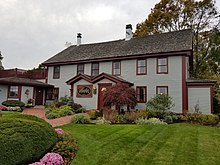
Homes
New settlers found adequate amount of wood and mud in New England, but few materials to mix them. They decided to design their homes with solid wooden structures and natural resources to acclimatize themselves to the long and cold winter and the short time suitable for agricultural work. Hence, wooden English cottages emerged in large numbers with thick clapboards nailed to the outside.
However, houses in New England are not unified. The Puritans dislodged some people to Rhode Island and Connecticut River valley and later more untrammeled colonists from other part of England. Compared with former architectures erected by the Puritans, their style is more laissez-faire, mixed with individual personality.
Another English architecture style is brought to New England in the First Period is façade gable, its purpose is to direct the rainwater away and introduce light to the attics, which is abandoned in the later Georgian style, an advanced version of First Period styles but more modern, demands highly symmetrical design.
The Williams–Barker House is a heritage house, its foundation finished in 1634 by house owner, John Williams, who was one of the earliest English immigrants in New England. From the outside, it could be seen that the timber frame supports the shape of the house and there is a central chimney to ventilate, few casement windows and a steep roof. Inside of the house, the ceiling is fairly low and wood beams are visible, fireplace is centered to ensure it heat up the house evenly and dining tables are placed surround it, due to its new use as a restaurant.
Public buildings
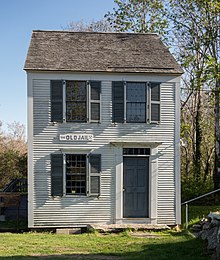
In colonial British America, jails are one of the earliest appeared public buildings, they did not serve the role of imprisonment, but a pre-trial accommodation for defendants. In Massachusetts Bay Colony, colonists established regulations that immigrants should not breach the laws in England and then erected houses of correction for penalty. At that time, recognizance is well accepted by colonial judges, so only few amount of criminals went to the jail, the scale is much smaller compared with contemporary jail in United States.
The structure is also different; the culprits live in cages or cabinets. A familial model is adopted in colonial jail system, jailers and perhaps their family live in the same building as the culprits. The jails imitates First Period residential places, built in wood structure and tight arranged planks.
The Old Jail established in Barnstable, Massachusetts was used for 130 years since 1690; the maximum capacity of whole jail is 6–8 people. Cells are small and windows are reinforced with rectangle metals, there is one door in the front which is small as well with heavy bar locks, and clapboards are interlocked at the joints with massive amount of nails.
Churches
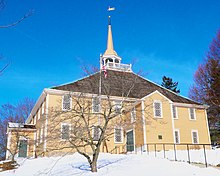
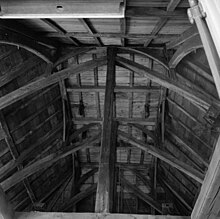
Christianity was brought to the United States by early English colonists; the oldest First Period church was built in New Mexico in 1629, named San Estevan del Rey Mission Church, is still in use as a museum. And later in Virginia, Maryland, and Massachusetts, few churches were constructed by Puritans following English medieval architecture styles in the 17th century.
Unlike Boston, cities like Plymouth and Hingham have not been restored to attract tourism, churches are well-maintained in original medieval architecture styling with centered fireplaces near the staircases.
Old Ship Church is one of the oldest church built by puritans in Hingham, Massachusetts, and a well-preserved example of First Period architecture style. It is named after the shape of ceiling, which was inspired by its architects, carpenters from the early arrived English colonists. The wooden timber frame of the church and walls were constructed in 1681, and later in the 1740s, galleries on the side were added.
Destruction
It is not surprising that First Period houses are damaged as time goes by, but it is not noticeable before 1876 as the Centennial at Philadelphia focused on the past glories.
Since only a small amount of architecture samples were left after World War II and the Great Depression, house owners could not afford the fees to restore the buildings, and wartime preoccupation distracted people from heritage preservation.
Another reason that first period houses are hard to preserve is erosion. During the 1930s, one of nine First Period houses collapsed due to decay of construction materials, wooden are easily rotten due to moisture and fungi (microscopic organisms). Apart from these two decades, First Period houses are demolishing at a stable rate, this is because the local historical commission scrutinizes the process of erosion regularly and takes actions immediately after finding endangered architectures.
To summarize, among over 250 buildings constructed in First Period, about 50 of them were lost, 15 of them were destroyed by fire, four of them collapsed, for the remaining buildings, 14 percent of them were demolished for better urban planning, such as road widening or school playgrounds. Only a small portion of First Period houses are maintained until now.
See also
- American historic carpentry
- Georgian style - Structures built from 1714 to 1830
- Federal-style - Structures built from c.1780 to 1830
- List of the oldest buildings in America
- First period houses in Massachusetts (1620–1659)
- First period houses in Massachusetts (1660–1679)
- Saltbox house
References
- Harris, Gordon (2015). "First Period, Georgian and Federal-era houses of Ipswich". Historic Ipswich on the Massachusetts North Shore. Retrieved October 13, 2020.
- Morrison, Hugh (1952). Early American Architecture: From the First Colonial Settlements to the National Period. Dover Publications. pp. 49–98.
- Augustus, Pugin (1915). A series of ornamental timber gables, from existing examples in England and France of the 16th Century. Cleveland: J. H. Jansen.
- Commonwealth of Massachusetts. "MACRIS inventory record for Ross Tavern". Massachusetts Historical Commission. Retrieved November 22, 2020.
- Harris, Richard (2008). Timber-framed Buildings. Shire: Shire Publications.
- Cousins, Frank; Riley, Phil M. (2000). The Colonial Architecture of Salem. New York: Dover Publications.
- "First Period construction". 17th & 18th Century houses of Essex County, Massachusetts. November 29, 2020. Retrieved November 21, 2023.
- "First Period, 1600-1700". Historic Portsmouth Architecture. April 3, 2015. Retrieved November 21, 2023.
- Harris, Gordon (August 18, 2017). "First Period construction". Historic Ipswich on the Massachusetts North Shore. Retrieved November 22, 2020.
- Tolles & Tolles, 2004.
- Sheldon, Noah; Wilson, Richard Guy (2004). The Colonial Revival House. New York: Harry N. Abrams.
- National Park Service (1987). Salem: maritime Salem in the Age of Sail. Washington: US Department of the Interior.
- Hubka, Thomas C. (2004). Big House, Little House, Back House, Barn: The Connected Farm Buildings of New England. Lebanon: University Press of New England.
- Lindgren, James M. (1995). Preserving historic New England: Preservation, progressivism, and the remaking of memory. Oxford: Oxford University Press.
- Pennsylvania Historical & Museum Commission. "Colonial Period 1640 - 1800". Pennsylvania Historical & Museum Commission. Retrieved November 22, 2020.
- Foster, Gerald (2004). American Houses: A Field Guide to the Architecture of the Home. Boston: Houghton Mifflin Company.
- Scott, Christianson (1998). With Liberty for Some: 500 Years of Imprisonment in America. Boston: Northeastern.
- Hirsch, Adam (1992). The Rise of the Penitentiary: Prisons and Punishment in Early America. London: Yale University Press.
- Rosenblum, Nancy (2000). Obligations of Citizenship and Demands of Faith: Religious Accommodation in Pluralist Democracies. Princeton: Princeton University Press. p. 156.
- Emily D'urso (2007). "Classic New England: Five for the Road". The Washington Post. Retrieved October 14, 2020.
- Butterfield, Fox (May 14, 1989). "The Perfect New England Village". New York Times. Retrieved October 14, 2020.
- Huber, Gregory D (2006). "Abbott Lowell Cummings' Prescience and Dates for First Period Houses of Massachusetts Bay Colony Using Dendrochronology". Material Culture. pp. 39–52.
- Floyd, Margaret Henderson. "Massachusetts and Its First Period Houses: A Statistical Survey". colonialsociety.org. Retrieved November 22, 2020.
- Zabel, Robert A.; Morrell, Jeffrey J. (2012). Wood Microbiology: Decay and Its Prevention. Cambridge: Cambridge Academic Press.
- Nilson, Tomas; Thorell, Kristina (2018). Cultural Heritage Preservation: The Past, the Present and the Future. Halmstad: Halmstad University Press.
- Alanen, Arnold R; Melnick, Robert (2000). Preserving cultural landscapes in America. Baltimore: Johns Hopkins University Press.
External links
- Essex National Heritage Area list of first period houses Archived March 17, 2013, at the Wayback Machine
| Architecture of the United States | |
|---|---|
| Native and indigenous | |
| Colonial and post-colonial | |
| Early Republic | |
| Mid-19th century | |
| Victorian | |
| Late-19th to mid-20th century |
|
| Post–World War II | |
| Building types and vernacular |
|
| Cities | |
| States | |